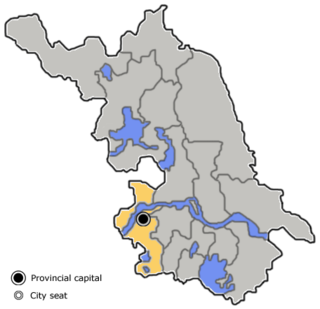
Nanjing, alternatively romanized as Nanking and Nankin, is the capital of Jiangsu province of the People's Republic of China and the second largest city in the East China region. With 11 districts, Nanjing, which is located in southwestern Jiangsu, has an administrative area of 6,600 km2 (2,500 sq mi) and a total population of 8,505,500 as of 2019.
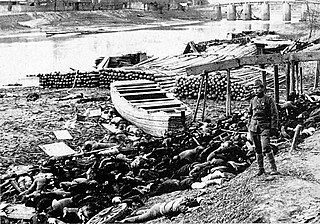
The Nanjing Massacre or the Rape of Nanjing was an episode of mass murder and mass rape committed by Imperial Japanese troops against the residents of Nanjing (Nanking), at that time the capital of China, during the Second Sino-Japanese War.

The Id Kah Mosque is a mosque located in Kashgar, Xinjiang, China.

Liu Zhi, or Liu Chih, was a Chinese Sunni Hanafi-Maturidi scholar of the Qing dynasty, belonging to the Huiru (Muslim) school of Neoconfucian thought. He was the most prominent of the Han Kitab writers who attempted to explain Muslim thought in the Chinese intellectual climate for a Hui Chinese audience, by frequently borrowing terminologies from Buddhism, Taoism and most prominently Neoconfucianism and aligning them with Islamic concepts. He was from the city of Nanjing. His magnum opus, T'ien-fang hsing-li or 'Nature and Principle in the Direction of Heaven', was considered the authoritative exposition of Islamic beliefs and has been republished twenty-five times between 1760 and 1939, and is constantly referred to by Muslims writing in Chinese.

The Presidential Palace in Nanjing, Jiangsu, China, housed the Office of the President of the Republic of China since 1927 until the capital was relocated to Taipei in 1949. It is now a museum called the China Modern History Museum. It is located at No.292 Changjiang Road, in the Xuanwu District of Nanjing.

As the Yuan dynasty ended, many Mongols as well as the Muslims who came with them remained in China. Most of their descendants took Chinese names and became part of the diverse cultural world of China. During the following Ming rule (1368–1644), Muslims truly adopted Chinese culture. Most became fluent in Chinese and adopted Chinese names and the capital, Nanjing, became a center of Islamic learning. As a result, the Muslims became "outwardly indistinguishable" from the Chinese.

The British School of Nanjing is a British Curriculum international school in Jiangning District, Nanjing, for children aged 2 to 18 years. It is a part of Nord Anglia Education.
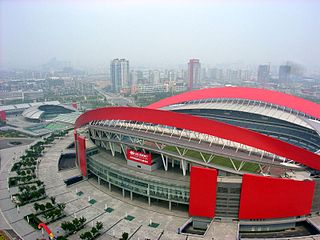
Jianye District is one of 11 districts of Nanjing, the capital of Jiangsu province, China.

The Hundred-word Eulogy is a 100-character praise of Islam and the Islamic prophet Muhammad written by the Hongwu Emperor of China. Copies of it are on display in several mosques in Nanjing, China.

Zhujianglu station is a station on Line 1 of the Nanjing Metro. It started operations on 3 September 2005 as part of the line's Phase I from Maigaoqiao to Andemen.

Zhangfuyuan station, is a station of Line 1 of the Nanjing Metro. It started operations on 3 September 2005 as part of the line's Phase I from Maigaoqiao to Andemen.

Sanshanjie station, is a station of Line 1 of the Nanjing Metro. Construction on the station began in 1992 in order for the Metro's engineers and designers to experiment and test their plans. Construction for the rest of Line 1 began eight years later in December 2000. It started operations on 3 September 2005 as part of the line's Phase I from Maigaoqiao to Andemen.

The Fuyou Road Mosque, also known as the North Mosque, is a mosque in Huangpu District, Shanghai, China.

The Nanning Mosque is a mosque in Xingning District, Nanning City, Guangxi, China.

The Jinjue Mosque is a mosque in Qinhuai District, Nanjing City, Jiangsu Province, China.

The Huxi Mosque is a mosque in Putuo District, Shanghai, China.
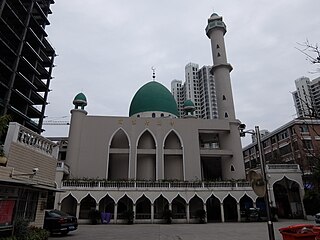
The Pudong Mosque is a mosque in Pudong, Shanghai, China.

Changsha Mosque is a mosque located on Mount Huilong (回龙山) in Tianxin District of Changsha, Hunan, China. Changsha Mosque is the site of Changsha Islamic Association.
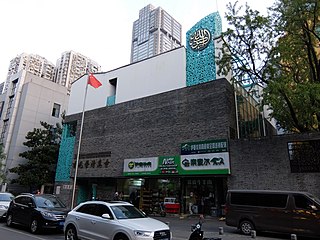
The Jizhaoying Mosque is a mosque in Xuanwu District, Nanjing, Jiangsu, China.




















